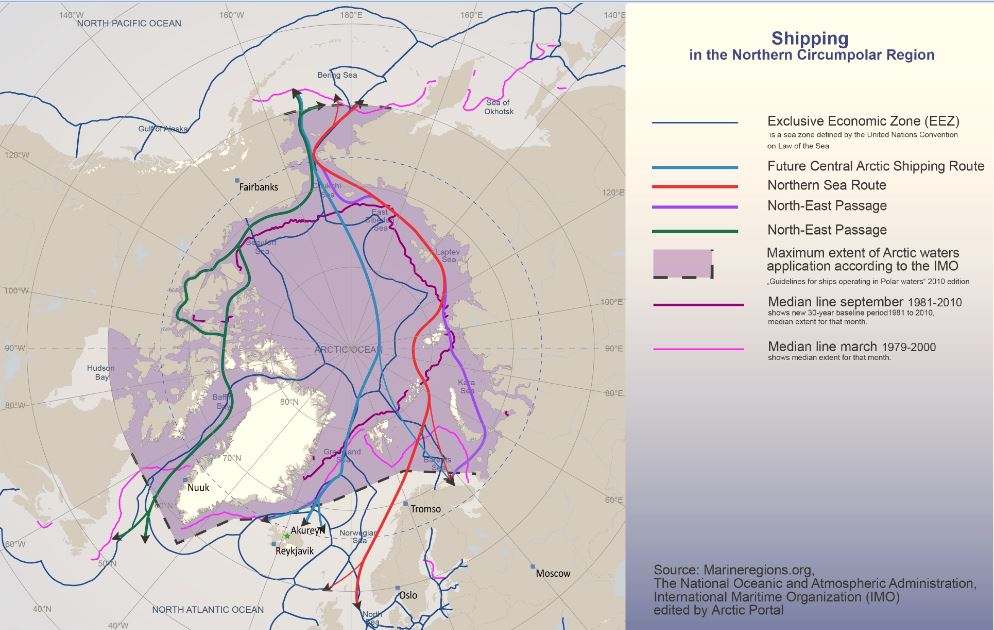Two days ago, TASS, the specialized Russian news agency, has confirmed Russia's decision to develop the Northern Sea Route up to twenty times its current capacity within the next 15 years.
As consequence of climate change, sea-ice is becoming thinner and thinner every year, while the ice-free seasons are becoming longer, making it possible to use the Northern Sea Route more safely and for more longer season. The Northern Sea Route may bear several commercial advantages for commercial shipping. First of all, it will considerably reduce transportation time, fuel consumption, and therefore environmental emission by cutting down distances between the main commercial ports in the World. For example, by using the Northern Sea Route, the distance between Asia and Europe would be approximately 40% shorter than via the Suez Canal or 60% shorter via the Cape of Good Hope. In addition, ships may avoid highly dangerous areas due to piracy. Indeed, as reported in a recent article published by "Time", "Southeast Asia was the location of 41% of the world's pirate attacks between 1995 and 2013. The West Indian Ocean, which includes Somalia, accounted for just 28%, and the West African coast only 18%. During those years, 136 seafarers were killed in Southeast Asian waters as a result of piracy — that's twice the number in the Horn of Africa, where Somalia lies, and more than those deaths and the fatalities suffered in West Africa combined.According to a 2010 study by the One Earth Future Foundation, piracy drains between $7 billion and $12 billion dollars from the international economy each year."(source: Time) Last, but not the least, ships would cut down waiting times and costs of using the Suez Canal.
Nevertheless, the Northern Sea Route may also present difficulties, as a general lack of infrastructures along the way, harsh climate conditions and higher environmental risks in case of accident (to name but a few). In any case, Russian's regulatory measures (read below), combined with the entry into force of the mandatory IMO International Code of Safety for Ships Operating in Polar Waters (Polar Code) in January 2017, may both contribute to considerably reduce risks associated with the use of the Northern Sea Route.
Here is the news as reported by TASS.
Russian Prime Minister Dmitry Medvedev signed the integrated development plan of the Northern Sea Route. The prime minister made the statement on Monday.
"This is the shortest route connecting Europe with the Far East, with the Asia-Pacific and the western part of the North America," the prime minister said. "One should admit its usage so far, softly speaking, is nothing to shout about," Medvedev added at the meeting with vice premiers.
Over 600 permits are annually issued at present for transportation of goods over the Northern Sea Route and the yearly goods transportation volume equals 4 mln tonnes, Deputy Prime Minister Arkady Dvorkovich said.
"The potential estimated for the period of [the nearest] 15 years, and this is the implementation timeframe of the integrated plan, is over 80 mln tonnes. In other words, a twentyfold increase is possible," Dvorkovich said.
It will make possible to surpass the goods traffic in times of the USSR, Dvorkovich added. "This goal is a must [to surpass transportation in the Soviet times]," the prime minister said.0vnk
The whole regulatory base required for implementation of the plan has already been developed by now, Dvorkovich said. The project provides for six main components, including navigation and hydrographic support in particular, he added. "At present there are actually no modern maps at the level they should be," the deputy prime minister said. There is no fully realized system of vessel navigation management and sea pollution control, Dvorkovich said. The issue of marine environment protection was raised as far back as at G8 summits when oil spills control was discussed, he said.
"There was a time when G8 was dealing with useful things, unlike now," Prime Minister Medvedev said.
Development of the search and rescue infrastructure on the Northern Sea Route has already started, Dvorkovich said. "Response teams are to be included already this year into crews of icebreakers escorting vessels; furthermore, development of key seaports will be supported," the deputy prime minister said.
A separate section of the plan is dedicated to interests of the Defense Ministry in safeguarding the Northern Sea Route, Dvorkovich said.
